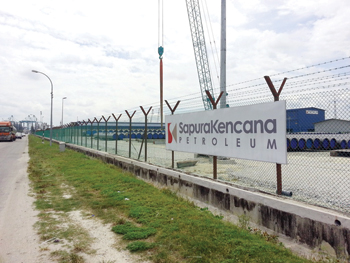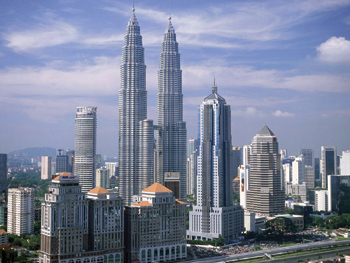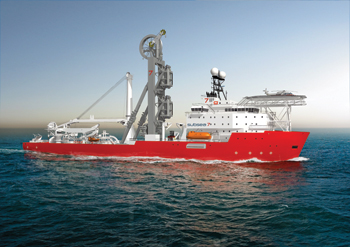
 Petronas ... one of the world’s largest oil and gas companies
Petronas ... one of the world’s largest oil and gas companies
PETROLIAM Nasional Berhad (Petronas) is one of the leading oil and gas companies in the world. The company undertakes the exploration, development, production, refining, storage, transportation, and distribution of oil, gas and petrochemical products around the world. Vertically integrated business structure coupled with geographical operations has strengthened the company’s business operations.
Strategic growth initiatives, worldwide potential for undeveloped oil and gas discoveries and increasing global crude oil and liquid fuel consumption could improve its business operations. However, volatility in oil and natural gas prices, stringent regulations, and exploration and developmental risks could affect the company’s business, says GlobalData in a strengths, weaknesses, opportunities and threats (SWOT) anaylsis of the company.
STRENGTHS
Global operations: Petronas is a vertically integrated oil and gas company with global operations. Geographical diversity has enabled the company to mitigate its dependence in single geography and to widen its revenue stream. Petronas operates in more than 30 countries across Africa, Asia, Europe, Australia and South America. Currently, it operates through associated companies, partly-owned companies and more than 40 wholly-owned subsidiaries. Petronas operates service stations in Malaysia and other countries including Indonesia, South Africa, Sudan and Thailand. It conducts exploration and production (E&P) in approximately 22 countries across Southeast Asia, the Middle East, Central Asia, Latin America and Africa.
It also has interest in the integrated Egyptian LNG project and the Dragon LNG regasification terminal in the UK. Petronas has interests in approximately 10,000 km of natural gas pipelines worldwide, including in Argentina, Australia, Thailand and Indonesia. Geographically, the company has operational presence in Asia, Malaysia, South Africa, and Rest of the world.
Strong LNG and gas business operations: Petronas through its gas and power business segment undertakes the processing, sale and transmission of natural gas; liquefaction, sale, transportation, regasification and trading of LNG; and other gas-related businesses. It also conducts gas transmission pipeline operations, marketing and trading, liquefied natural gas (LNG) shipping, gas district cooling and supply of industrial utilities. Strong LNG and gas business operations have strengthened the company’s business operations.
The company’s LNG complex in Bintulu, Sarawak is one of the world’s largest LNG production facilities at a single location with a combined capacity of about 24 million tonnes per annum (mtpa). It also has interest in the integrated Egyptian LNG project and the Dragon LNG regasification terminal in the UK. Petronas has interests in approximately 10,000 km of natural gas pipelines worldwide, including in Argentina, Australia, Thailand and Indonesia. In Malaysia, Petronas supplies natural gas through the Peninsular Gas Utilisation (PGU) system, which delivers supplies to the power, industrial, petrochemical and other sectors throughout Peninsular Malaysia.
For the fiscal year ended December 2013, the company’s total LNG sales volume increased to 28.9 mtpa as compared to 26 mtpa in 2012. The increase in LNG sales volume was due to higher LNG production at its complex in Bintulu. For the fiscal year ended December 2013, the company produced 25.1 mtpa of LNG from its complex as compared to 26.1 mmt in 2012. Its gas pipeline network operated at a higher reliability rate in 2013 as compared to 2012. In fiscal year ended December 2013, the company’s PGU operated at 99.97 per cent reliability rate and its GPP operated at 99.99 per cent reliability rate. Increase in LNG sales volume has enhanced its gas and power segmental revenue by 16.3 per cent to MYR99.9 billion as compared to MYR 85.8 billion in 2012.
Vertically integrated operations: Petronas explores, develops, produces, transports, refines and distributes oil, gas and petrochemical products in domestic and international markets. Integrated operations and diversified geographical activities enable the group to mitigate the risks associated with operating in select segments. It undertakes the exploration, development and production of oil and gas in Malaysia and abroad.
The group has production sharing contracts with international oil and gas companies operating in Malaysia. Petronas’s gas and power business consists of the production and sale of gas and power. The gas and power division operates LNG plants in Malaysia and Egypt. It carries out gas and energy trading across Malaysia and Europe. The division supplies gas to power generation facilities in Malaysia. Its downstream business division conducts refining, trading, marketing and petrochemicals operations. The division has three refineries in Malaysia and one refinery in South Africa. The division trades in energy in all international markets. It distributes various petroleum products including LPG, gasoline, jet fuel, diesel, lubricants, asphalt and fuel oil across Malaysia.
 |
Petronas ... vertically integrated operations mitigate risks |
Petronas operates service stations in Malaysia and other countries including Indonesia, South Africa, Sudan and Thailand. The company operates a total of approximately 2,500 retail outlets under PDB and Engen across Malaysia and the African continents. It also supplies lubricants to Mercedes OEM and strengthens the brand through the development of Fluid Technology Solutions for Mercedes GP team in Formula One. Its portfolio of lubricant brands includes Selenia, Syntium and Urania. In fiscal year ended December 2013, the company generated approximately 4.9 per cent of the company’s total revenue from corporate and others business segment; 39.6 per cent from downstream segment; 30.3 per cent from E&P segment; and 25.2 per cent from gas and power segment.
WEAKNESSES
Declining refinery utilisation rate: Petronas reported decline in its refinery performance during 2013. For the fiscal year ended December 2013, the company’s domestic refineries’ plant utilisation rate declined to 83.9 per cent as compared to 88 per cent in 2012. Its PCG refinery’s utilisation rate declined to 77.9 per cent in 2013 as compared to 82.5 per cent in 2012.
In fiscal year ended December 2013, the company’s Engen refinery’s capacity utilisation rate declined to 75 per cent as compared to 78.3 per cent in 2012. The decline in domestic refineries’ capacity utilisation rate was due to unplanned refinery shutdowns during 2013. Engen refinery’s utilisation rate declined due to extended shutdowns and delayed crude procurement activity in 2013. PCG’s utilisation rate was lower due to statutory turnaround time and higher level of maintenance activities.
Decline in utilisation rate for its refinery and petrochemical assets has affected the company’s petrochemical sales volume during 2013. For the fiscal year ended December 2013, the company’s petrochemical sales volume declined to 6 mmt as compared to 6.8 mmt in 2012.
OPPORTUNITIES
Global crude and liquid fuel consumption: Petronas could further strengthen its business operations with the increasing global crude and liquid fuel consumption. World liquid fuel consumption grew by 0.8 million barrels per day (mbpd) in 2012 to reach 89.1 mbpd. According to US EIA, this growth rate will be higher in 2013 and 2014 because of a moderate recovery in global economy. US EIA forecasts global crude oil consumption to reach 90.1 mbpd in 2013 and 91.5 mbpd in 2014.
Non-OECD Asia is the leading regional contributor to the expected growth in global consumption. EIA expects refinery crude oil inputs in China to increase in 2013 as oil product inventories are restocked and new refining capacity comes on line. EIA estimates that liquid fuel consumption in China increased by 380,000 bpd in 2012, and will increase by 450,000 bpd in 2013 and by 510,000 bpd in 2014.
This compares with annual average growth of 540,000 bpd from 2004 through 2010. OECD liquid fuel consumption fell by 0.5 mbpd in 2012. EIA projects OECD consumption to decline further by 0.3 mbpd in 2013 because of declining consumption in Europe. OECD consumption stalls in 2014 as European consumption begins to recover in response to higher economic growth. Such increasing consumption in non-OECD countries could enhance the company’s business operations further.
Growth initiatives: Petronas has substantial focus on strengthening its business operations through various new organic and inorganic initiatives. In February 2014, the company entered into an agreement to acquire 25 per cent stake in Progress Energy Canada, to an Indian company and an Asian gas buyer. In same month, the company reached the Final Investment Decision (FID) for its second floating liquefied natural gas facility (PFLNG 2) project, located off the coast of Sabah in Malaysia.
In December 2013, Brunei National Petroleum Company Sendirian Berhad signed an agreement to acquire a 3 per cent interest in natural gas assets located in British Columbia, Canada from Progress Energy Canada, a subsidiary of the company. In November 2013, the company’s subsidiary Progress Energy Canada, reached an agreement to acquire an approximately 75 per cent interest in Montney Shale natural gas acreage in northeast British Columbia. In October 2013, the company announced its plans to build an LNG plant and pipeline in Canada with a total investment of approximately $35 billion.
In June 2013, the company’s subsidiary Petronas Suriname E&P signed a farm out agreement with RWE Dea to sell its 40 per cent interest in the license Block 52 in Guyana-Suriname Basin, off the coast Suriname. In January 2013, the company and Evonik Industries signed a letter of intent (LoI) to jointly embark on the development of production facilities of specialty chemicals within Petronas’s Refinery & Petrochemical Integrated Development (Rapid) project in Pengerang, Johor. Such growth initiatives could further enhance the company’s business operations further.
Global potential for undeveloped discoveries: Petronas is and global vertically integrated oil and gas company. The company could further strengthen its business operations with the global potential for undeveloped discoveries. Around the globe there are nearly 1.4 trillion barrels of oil equivalent (boe) reserves in conventional undeveloped oil and gas fields.
This includes nearly 1.1 trillion boe of technical reserves. These reserves have an indicative collective value of approximately $760 billion. Technical reserve in Middle East have total value of approximately $185 billion; Latin America with $149 billion; North America with $132 billion; Africa with $125 billion; Russia and Caspian with $78 billion; Asia-Pacific with $67 billion; and Europe with $24 billion.
The region with the most valuable portfolio of good technicals overall is the Middle East, followed closely by Latin America and North America. The huge reserves in Middle East region is due to undeveloped volumes in the supergiant North/South Pars gas field which extends between Qatar and Iran in the Persian Gulf. There are also around 300 billion boe of undeveloped commercial reserves which should be brought on-stream by 2023.
The undeveloped commercial reserves are weighted towards gas (60:40), while technical reserves comprise slightly more liquids (55:45). Significant regional variations exist however such as Asia-Pacific is gas dominated (85 per cent) due to the huge gas discoveries offshore Australia and elsewhere, while both North and Latin America are oil-dominated (each approximately 90 per cent) due to their world-scale undeveloped Canadian and Venezuelan oil sands and heavy oil deposits. Such huge global undeveloped reserves could provide the company with various new growth opportunities.
THREATS
Exploration production and development risks: Future oil and gas exploration and production may involve unprofitable efforts, not only from dry wells but also from producing wells, when they are not commercially viable. The combination of technology and recovery cost may be higher than revenue earned owing to production.
In addition, drilling hazards and environmental damage could lead to well shut down. Operational risks such as unexpected formations or pressure, bow-outs and fire, which could result in loss of life and damage to properties would cause production delays and permanent well shut downs. The company has a higher degree of threat due to future exploration development and production uncertainties. This could affect the company’s future revenue.
Volatility in oil and natural gas prices: The company’s revenue, profitability, and rate of growth are substantially dependent on prices of oil and natural gas. In recent years, increase in the demand for crude oil and depletion in the oil reserves resulted in increase in the prices of crude oil and oil products across the world. Oil prices and markets have been extremely volatile in the recent years. Prices are affected by numerous factors such as market supply and demand, political and economic conditions, and the ability of the Organization of Petroleum Exporting Countries (Opec) to set and maintain production and price targets.
As a result of the uncertainties over the supply and demand of these commodities, petroleum prices are expected to remain volatile in the near future, which could affect profitability of the company. Any such volatility in oil and gas prices could adversely affect the company’s results of operations, financial condition, and future growth rate.
Stringent laws and regulations: The oil and gas industry is subject to various national, regional and local environmental laws and regulations related to the E&P of oil and gas, petroleum and petrochemical products and other activities. According to these laws and regulations, in many regions, companies must file for an environmental evaluation report and get approval prior to the commencement of exploration, production, refining and chemical projects. Companies must restrict the type, quantities and concentration of various substances related to drilling and production activities that can be released into the environment. Environmental laws and regulations also limit or prohibit drilling within protected areas and certain other areas; and impose penalties for pollution resulting from oil, natural gas and petrochemical operations, including criminal and civil liabilities. In such a scenario, the group could incur heavy expenses in order to adhere to industry norms in all the regions where it has operations.










































































